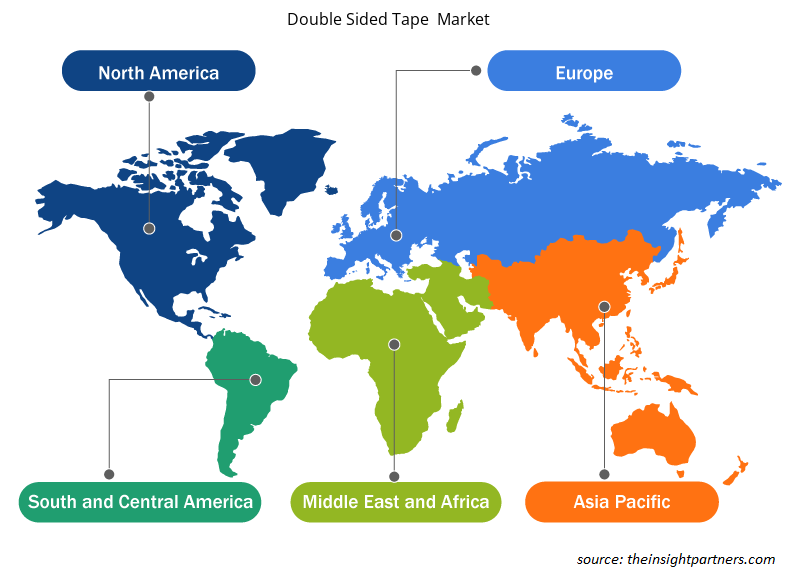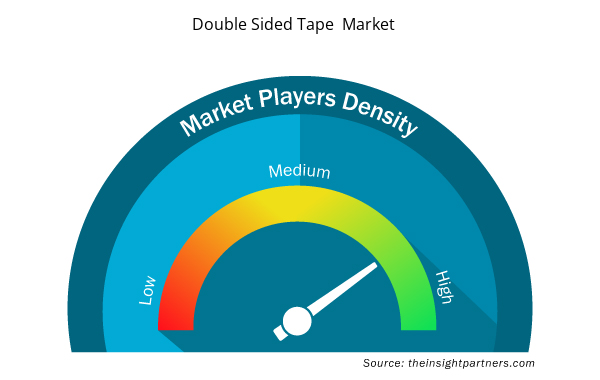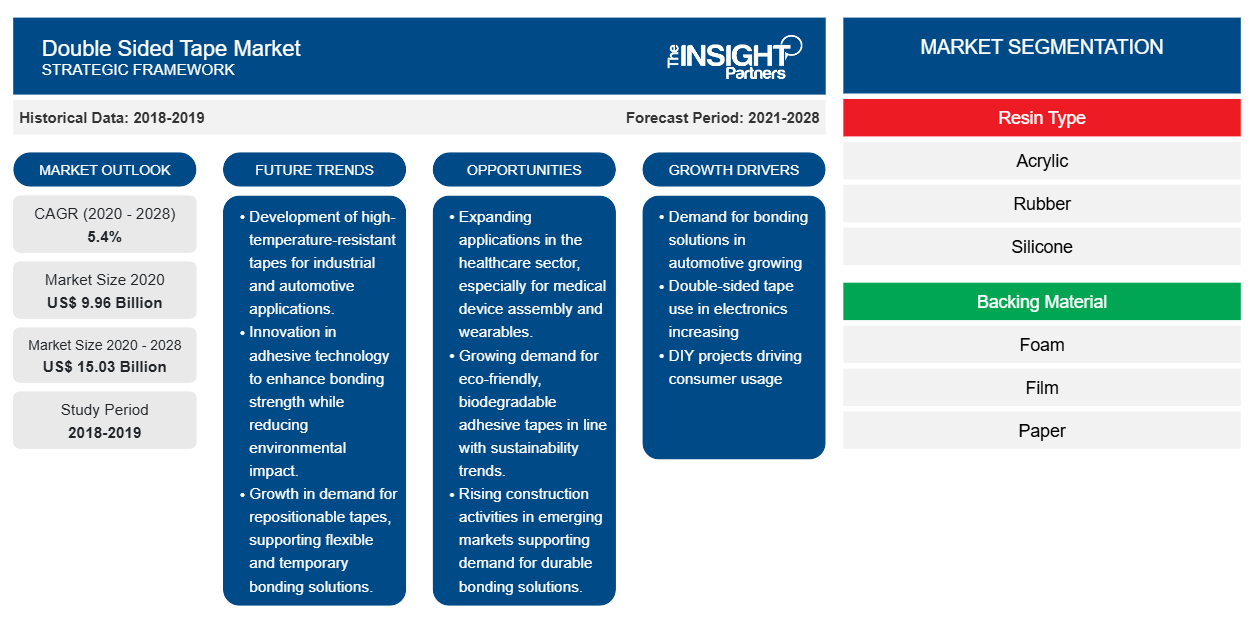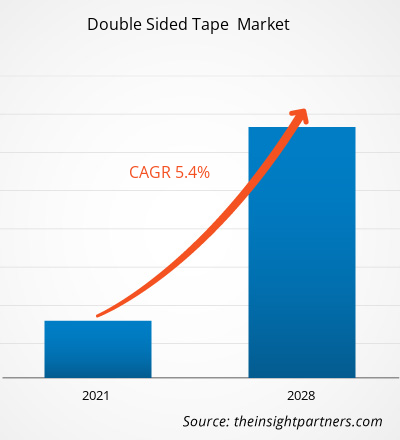Der Markt für doppelseitiges Klebeband hatte im Jahr 2020 einen Wert von 9.963,74 Millionen US-Dollar und soll bis 2028 einen Wert von 15.028,98 Millionen US-Dollar erreichen; von 2020 bis 2028 wird mit einer durchschnittlichen jährlichen Wachstumsrate von 5,4 % gerechnet.
Ein doppelseitiges Klebeband ist ein druckempfindliches Klebeband, das auf beiden Seiten mit einer Klebeschicht beschichtet ist. Da diese Bänder zwei Oberflächen zusammenkleben können, werden sie in einer Vielzahl von Anwendungen eingesetzt. Sie werden zum Befestigen und Verbinden in vielen Fertigungsindustrien verwendet, beispielsweise in der Automobilindustrie, im Gesundheitswesen sowie im Baugewerbe. Die Verwendung doppelseitiger Bänder ist eine bessere Option als Schrauben und Nieten, da die Oberflächenspannung gleichmäßig über die Oberfläche verteilt wird.
Der COVID-19-Ausbruch hat sich aufgrund von Lockdowns, Reiseverboten und Betriebsschließungen negativ auf die Wirtschaft und Industrie in verschiedenen Ländern ausgewirkt. Die Chemie- und Materialindustrie ist eine der wichtigsten Branchen, die unter schweren Störungen wie Unterbrechungen der Lieferkette, Absagen von Technologieveranstaltungen und Büroschließungen leidet. Die Schließung verschiedener Anlagen und Fabriken in führenden Regionen wie Nordamerika, Europa, Asien-Pazifik, Südamerika, dem Nahen Osten und Afrika hat die globale Lieferkette eingeschränkt und die Fertigungsaktivitäten, Lieferpläne und den Verkauf verschiedener Chemikalien und Materialien behindert. Darüber hinaus haben verschiedene Unternehmen bereits mögliche Verzögerungen bei Produktlieferungen und einen Einbruch der zukünftigen Verkäufe ihrer Produkte angekündigt. Darüber hinaus behindern die von Ländern in Europa, Asien und Nordamerika verhängten globalen Reiseverbote die Möglichkeiten für Geschäftskooperationen und Partnerschaften. All diese Faktoren wirken sich negativ auf die Chemie- und Materialindustrie aus, was das Wachstum verschiedener mit dieser Branche verbundener Märkte bremst.
Passen Sie diesen Bericht Ihren Anforderungen an
Sie erhalten kostenlose Anpassungen an jedem Bericht, einschließlich Teilen dieses Berichts oder einer Analyse auf Länderebene, eines Excel-Datenpakets sowie tolle Angebote und Rabatte für Start-ups und Universitäten.
- Holen Sie sich die wichtigsten Markttrends aus diesem Bericht.Dieses KOSTENLOSE Beispiel umfasst eine Datenanalyse von Markttrends bis hin zu Schätzungen und Prognosen.
Markteinblicke
Breites Anwendungsspektrum von doppelseitigem Klebeband
Doppelseitiges Klebeband ist ein druckempfindliches Klebeband, das auf beiden Seiten mit Klebstoff beschichtet ist und in vielen Fertigungsindustrien zum Befestigen und Verkleben verwendet wird, beispielsweise in der Automobilindustrie, im Gesundheitswesen sowie im Baugewerbe. Doppelseitiges Klebeband ist eine bessere Option als Schrauben und Nieten, da die Oberflächenspannung gleichmäßig über die Oberfläche verteilt wird.
Ein doppelseitiges Klebeband ist ein druckempfindliches Klebeband, das auf beiden Seiten mit einer Klebeschicht beschichtet ist. Da diese Bänder zwei Oberflächen zusammenkleben können, werden sie in einer Vielzahl von Anwendungen eingesetzt. Der viskose, flüssigkeitsähnliche Klebstoff dieser Bänder haftet bei Druck auf einer Oberfläche. Der Klebstoff fließt auf die Oberfläche und hilft, zwei Substrate zusammenzuhalten. Doppelseitige Bänder werden hauptsächlich in der Papier- und Druckindustrie, in der Elektro- und Elektronikindustrie, in der Verpackungsindustrie und in der Automobilindustrie eingesetzt. Das Wachstum des Marktes ist hauptsächlich auf die weit verbreitete Verwendung von doppelseitigen Bändern in Automobilanwendungen wie Emblemen und Typenschildern, Platten, Dachleisten, Schwellerverkleidungen, Seitenspiegeln und Heckspoilern zurückzuführen. Darüber hinaus werden diese Bänder häufig im Außenbereich von Autos verwendet, darunter Türverkleidungen, Dichtungen und Spoiler sowie Halterungen für Parksensoren. Überlegene Eigenschaften dieser Bänder wie Vibrations- und Geräuschreduzierung werden voraussichtlich die Nachfrage nach doppelseitigen Bändern in Automobilanwendungen steigern.
Doppelseitige Klebebänder werden bei der Papierherstellung häufig verwendet. Sie sorgen für Kontinuität beim Betrieb von Papiermaschinen, Kalandern, Querschneidern und Beschichtungsanlagen, was bei bestimmten integralen Aufgaben wie Rollenschließen, Kernstart und Spleißen während des gesamten Papierherstellungsprozesses von Vorteil ist. Die Nachfrage nach doppelseitigen Klebebändern in der Papier- und Druckindustrie kommt hauptsächlich aus der Digitaldruck- und Einzelhandelsbranche.sheeters, and coaters, which benefits in certain integral tasks, such as reel closing, core starting, and splicing, throughout the paper's manufacturing process. The demand for double sided tapes in the paper & printing industry mainly comes from digital printing and retail industries.
Einblicke in den Harztyp
Basierend auf dem Harztyp ist der Markt für doppelseitiges Klebeband in Acryl, Gummi, Silikon und andere unterteilt. Das Silikonsegment hatte im Jahr 2020 den größten Marktanteil. Silikonklebeband ist ein flexibles, wasserdichtes und nicht gewebtes Material mit einem einzigartigen Silikonkleber. Es ist pilzresistent und kann Ozon und ultraviolette Strahlung in Außenumgebungen bekämpfen. Sie sind außerdem lösungsmittelbeständig und weisen eine hohe Scher- und Schälfestigkeit auf. Darüber hinaus sind diese Klebstoffe vergleichsweise teuer und haben eine geringere Anfangshaftung, können aber höheren Temperaturen standhalten als Acryl- und Gummiklebstoffe.
Faktoren wie die zunehmende Zahl älterer Menschen, die zunehmende Verbreitung chronischer Krankheiten und die steigende Bevölkerungszahl beflügeln die globale Medizinbranche, was wiederum das Wachstum des Marktes für doppelseitiges Klebeband im Silikonsegment vorantreibt. Darüber hinaus treiben mehrere Faktoren wie staatliche Unterstützung, schnelles Wirtschaftswachstum und die Verfügbarkeit von Rohstoffen und billigen Arbeitskräften den Markt für Silikonklebebänder weltweit voran.
Einige wichtige Marktteilnehmer auf dem Markt für doppelseitiges Klebeband sind 3M; Nitto Denko Corporation; Tesa SE; Intertape Polymer Group; Shurtape Technologies, LLC; Scapa; Guangzhou Broadya Adhesive Products Co., Ltd.; Lohmann GmbH & Co.KG; LINTEC Corporation; und Avery Dennison Corporation. Wichtige Marktteilnehmer verfolgen Strategien wie Fusionen und Übernahmen sowie Produkteinführungen, um ihre geografische Präsenz und Kundenbasis weltweit zu erweitern.Nitto Denko Corporation; Tesa SE; Intertape Polymer Group; Shurtape Technologies, LLC; Scapa; Guangzhou Broadya Adhesive Products Co., Ltd.; Lohmann GmbH & Co.KG; LINTEC Corporation; and Avery Dennison Corporation. Major players in the market are adopting strategies such as mergers and acquisitions, and product launches to expand their geographical presence and consumer base globally.
Bericht-Spotlights
- Fortschrittliche Branchentrends auf dem Markt für doppelseitiges Klebeband helfen den Akteuren bei der Entwicklung wirksamer langfristiger Strategien
- In Industrie- und Entwicklungsländern angewandte Strategien für Unternehmenswachstum
- Quantitative Analyse des Marktes für doppelseitiges Klebeband von 2018 bis 2028
- Schätzung der Nachfrage nach doppelseitigem Klebeband in verschiedenen Branchen
- PEST-Analyse zur Veranschaulichung der Wirksamkeit der in der Branche tätigen Käufer und Lieferanten bei der Vorhersage des Marktwachstums
- Aktuelle Entwicklungen zum Verständnis des Wettbewerbsmarktszenarios und der Nachfrage nach doppelseitigem Klebeband
- Markttrends und -aussichten in Verbindung mit Faktoren, die das Wachstum des doppelseitigen Klebebandmarktes vorantreiben und bremsen
- Entscheidungsprozess durch das Verständnis von Strategien, die das kommerzielle Interesse im Hinblick auf das Wachstum des doppelseitigen Klebebandmarktes untermauern
- Marktgröße für doppelseitiges Klebeband an verschiedenen Marktknoten
- Detaillierte Übersicht und Segmentierung des doppelseitigen Klebebandmarktes sowie seiner Dynamik in der Branche
- Marktgröße für doppelseitiges Klebeband in verschiedenen Regionen mit vielversprechenden Wachstumschancen
Doppelseitiges Klebeband
Regionale Einblicke in den Markt für doppelseitiges Klebeband
Die regionalen Trends und Faktoren, die den Markt für doppelseitiges Klebeband während des gesamten Prognosezeitraums beeinflussen, wurden von den Analysten von Insight Partners ausführlich erläutert. In diesem Abschnitt werden auch die Marktsegmente und die Geografie für doppelseitiges Klebeband in Nordamerika, Europa, im asiatisch-pazifischen Raum, im Nahen Osten und Afrika sowie in Süd- und Mittelamerika erörtert.

- Holen Sie sich die regionalspezifischen Daten für den Markt für doppelseitiges Klebeband
Umfang des Marktberichts über doppelseitiges Klebeband
| Berichtsattribut | Details |
|---|---|
| Marktgröße im Jahr 2020 | 9,96 Milliarden US-Dollar |
| Marktgröße bis 2028 | 15,03 Milliarden US-Dollar |
| Globale CAGR (2020 - 2028) | 5,4 % |
| Historische Daten | 2018-2019 |
| Prognosezeitraum | 2021-2028 |
| Abgedeckte Segmente | Nach Harztyp
|
| Abgedeckte Regionen und Länder | Nordamerika
|
| Marktführer und wichtige Unternehmensprofile |
|
Marktdichte von doppelseitigem Klebeband: Auswirkungen auf die Geschäftsdynamik verstehen
Der Markt für doppelseitiges Klebeband wächst rasant, angetrieben durch die steigende Nachfrage der Endverbraucher aufgrund von Faktoren wie sich entwickelnden Verbraucherpräferenzen, technologischen Fortschritten und einem größeren Bewusstsein für die Vorteile des Produkts. Mit steigender Nachfrage erweitern Unternehmen ihr Angebot, entwickeln Innovationen, um die Bedürfnisse der Verbraucher zu erfüllen, und nutzen neue Trends, was das Marktwachstum weiter ankurbelt.
Die Marktteilnehmerdichte bezieht sich auf die Verteilung der Firmen oder Unternehmen, die in einem bestimmten Markt oder einer bestimmten Branche tätig sind. Sie gibt an, wie viele Wettbewerber (Marktteilnehmer) in einem bestimmten Marktraum im Verhältnis zu seiner Größe oder seinem gesamten Marktwert präsent sind.
Die wichtigsten auf dem Markt für doppelseitiges Klebeband tätigen Unternehmen sind:
- 3M
- Nitto Denko Corporation
- Tesa SE
- Intertape Polymer Gruppe
- Shurtape Technologies, LLC
Haftungsausschluss : Die oben aufgeführten Unternehmen sind nicht in einer bestimmten Reihenfolge aufgeführt.

- Überblick über die wichtigsten Akteure auf dem Markt für doppelseitiges Klebeband
Markt für doppelseitiges Klebeband nach Harztyp
- Acryl
- Gummi
- Silikon
- Sonstiges
Markt für doppelseitiges Klebeband nach Trägermaterial
- Schaum
- Film
- Papier
- Sonstiges
Markt für doppelseitiges Klebeband nach Endverbrauch
- Gesundheitspflege
- Bauwesen
- Automobilindustrie
- Konsumgüter
- Sonstiges
Firmenprofile
- 3M
- Nitto Denko Corporation
- Tesa SE
- Intertape Polymer Gruppe
- Shurtape Technologies, LLC
- Scapa
- Guangzhou Broadya Klebstoffprodukte Co., Ltd.
- Lohmann GmbH & Co.KG
- LINTEC Corporation
- Avery Dennison Corporation
- Historische Analyse (2 Jahre), Basisjahr, Prognose (7 Jahre) mit CAGR
- PEST- und SWOT-Analyse
- Marktgröße Wert/Volumen – Global, Regional, Land
- Branche und Wettbewerbsumfeld
- Excel-Datensatz



Report Coverage
Revenue forecast, Company Analysis, Industry landscape, Growth factors, and Trends

Segment Covered
This text is related
to segments covered.

Regional Scope
North America, Europe, Asia Pacific, Middle East & Africa, South & Central America

Country Scope
This text is related
to country scope.
Häufig gestellte Fragen
The acrylic resin type segment is expected to grow at the fastest rate. They exhibit superior strength and can last longer in harsh conditions such as extreme cold or under exposure to direct sunlight. Acrylic based double sided tapes are widely used over traditional packaging materials owing to their biological and mechanical filtration properties. The market is expected to witness an increase in the product demand in flexible packaging solutions. The strong demand for corrugated boxes coupled with the thriving packaged food industry in the Asia Pacific region is expected to boost the growth of acrylic segment of the double sided tapes market.
The major players operating in the global double sided tapes market are 3M, Nitto Denko Corporation, tesa SE, Intertape Polymer Group, Shurtape Technologies, LLC, Scapa, Guangzhou Broadya Adhesive Products Co., Ltd., Lohmann GmbH & Co.KG, LINTEC Corporation, and Avery Dennison Corporation among many others.
Double-sided tape is a pressure-sensitive tape coated with an adhesive on both sides and are used for fixing and bonding in many manufacturing industries, such as automotive, healthcare, and building and construction. Using double sided tapes is a better option than screws and rivets as the surface tension is spread evenly across the surface. Double-sided tapes have major applications in paper & printing, electrical & electronics, packaging, and automotive industries. The growth of the market is mainly attributed to the widespread use of double-sided tapes in automotive applications such as emblem & nameplates, plate panels, roof molding, rocker panel/cladding, side mirrors, and rear spoilers. Moreover, these tapes are widely utilized in car exteriors, which include door cladding, seals and spoiler, and parking sensor retainers. Superior characteristics of these tapes such as vibration and noise reduction, are anticipated to boost the demand for double-sided tapes in automotive applications
Trends and growth analysis reports related to Chemicals and Materials : READ MORE..
The List of Companies - Double-Sided Tape Market
- 3M
- Nitto Denko Corporation
- Tesa SE
- Intertape Polymer Group
- Shurtape Technologies, LLC
- Scapa
- Guangzhou Broadya Adhesive Products Co., Ltd.
- Lohmann GmbH & Co.KG
- LINTEC Corporation
- Avery Dennison Corporation
The Insight Partners performs research in 4 major stages: Data Collection & Secondary Research, Primary Research, Data Analysis and Data Triangulation & Final Review.
- Data Collection and Secondary Research:
As a market research and consulting firm operating from a decade, we have published and advised several client across the globe. First step for any study will start with an assessment of currently available data and insights from existing reports. Further, historical and current market information is collected from Investor Presentations, Annual Reports, SEC Filings, etc., and other information related to company’s performance and market positioning are gathered from Paid Databases (Factiva, Hoovers, and Reuters) and various other publications available in public domain.
Several associations trade associates, technical forums, institutes, societies and organization are accessed to gain technical as well as market related insights through their publications such as research papers, blogs and press releases related to the studies are referred to get cues about the market. Further, white papers, journals, magazines, and other news articles published in last 3 years are scrutinized and analyzed to understand the current market trends.
- Primary Research:
The primarily interview analysis comprise of data obtained from industry participants interview and answers to survey questions gathered by in-house primary team.
For primary research, interviews are conducted with industry experts/CEOs/Marketing Managers/VPs/Subject Matter Experts from both demand and supply side to get a 360-degree view of the market. The primary team conducts several interviews based on the complexity of the markets to understand the various market trends and dynamics which makes research more credible and precise.
A typical research interview fulfils the following functions:
- Provides first-hand information on the market size, market trends, growth trends, competitive landscape, and outlook
- Validates and strengthens in-house secondary research findings
- Develops the analysis team’s expertise and market understanding
Primary research involves email interactions and telephone interviews for each market, category, segment, and sub-segment across geographies. The participants who typically take part in such a process include, but are not limited to:
- Industry participants: VPs, business development managers, market intelligence managers and national sales managers
- Outside experts: Valuation experts, research analysts and key opinion leaders specializing in the electronics and semiconductor industry.
Below is the breakup of our primary respondents by company, designation, and region:

Once we receive the confirmation from primary research sources or primary respondents, we finalize the base year market estimation and forecast the data as per the macroeconomic and microeconomic factors assessed during data collection.
- Data Analysis:
Once data is validated through both secondary as well as primary respondents, we finalize the market estimations by hypothesis formulation and factor analysis at regional and country level.
- Macro-Economic Factor Analysis:
We analyse macroeconomic indicators such the gross domestic product (GDP), increase in the demand for goods and services across industries, technological advancement, regional economic growth, governmental policies, the influence of COVID-19, PEST analysis, and other aspects. This analysis aids in setting benchmarks for various nations/regions and approximating market splits. Additionally, the general trend of the aforementioned components aid in determining the market's development possibilities.
- Country Level Data:
Various factors that are especially aligned to the country are taken into account to determine the market size for a certain area and country, including the presence of vendors, such as headquarters and offices, the country's GDP, demand patterns, and industry growth. To comprehend the market dynamics for the nation, a number of growth variables, inhibitors, application areas, and current market trends are researched. The aforementioned elements aid in determining the country's overall market's growth potential.
- Company Profile:
The “Table of Contents” is formulated by listing and analyzing more than 25 - 30 companies operating in the market ecosystem across geographies. However, we profile only 10 companies as a standard practice in our syndicate reports. These 10 companies comprise leading, emerging, and regional players. Nonetheless, our analysis is not restricted to the 10 listed companies, we also analyze other companies present in the market to develop a holistic view and understand the prevailing trends. The “Company Profiles” section in the report covers key facts, business description, products & services, financial information, SWOT analysis, and key developments. The financial information presented is extracted from the annual reports and official documents of the publicly listed companies. Upon collecting the information for the sections of respective companies, we verify them via various primary sources and then compile the data in respective company profiles. The company level information helps us in deriving the base number as well as in forecasting the market size.
- Developing Base Number:
Aggregation of sales statistics (2020-2022) and macro-economic factor, and other secondary and primary research insights are utilized to arrive at base number and related market shares for 2022. The data gaps are identified in this step and relevant market data is analyzed, collected from paid primary interviews or databases. On finalizing the base year market size, forecasts are developed on the basis of macro-economic, industry and market growth factors and company level analysis.
- Data Triangulation and Final Review:
The market findings and base year market size calculations are validated from supply as well as demand side. Demand side validations are based on macro-economic factor analysis and benchmarks for respective regions and countries. In case of supply side validations, revenues of major companies are estimated (in case not available) based on industry benchmark, approximate number of employees, product portfolio, and primary interviews revenues are gathered. Further revenue from target product/service segment is assessed to avoid overshooting of market statistics. In case of heavy deviations between supply and demand side values, all thes steps are repeated to achieve synchronization.
We follow an iterative model, wherein we share our research findings with Subject Matter Experts (SME’s) and Key Opinion Leaders (KOLs) until consensus view of the market is not formulated – this model negates any drastic deviation in the opinions of experts. Only validated and universally acceptable research findings are quoted in our reports.
We have important check points that we use to validate our research findings – which we call – data triangulation, where we validate the information, we generate from secondary sources with primary interviews and then we re-validate with our internal data bases and Subject matter experts. This comprehensive model enables us to deliver high quality, reliable data in shortest possible time.


 Holen Sie sich ein kostenloses Muster für diesen Bericht
Holen Sie sich ein kostenloses Muster für diesen Bericht